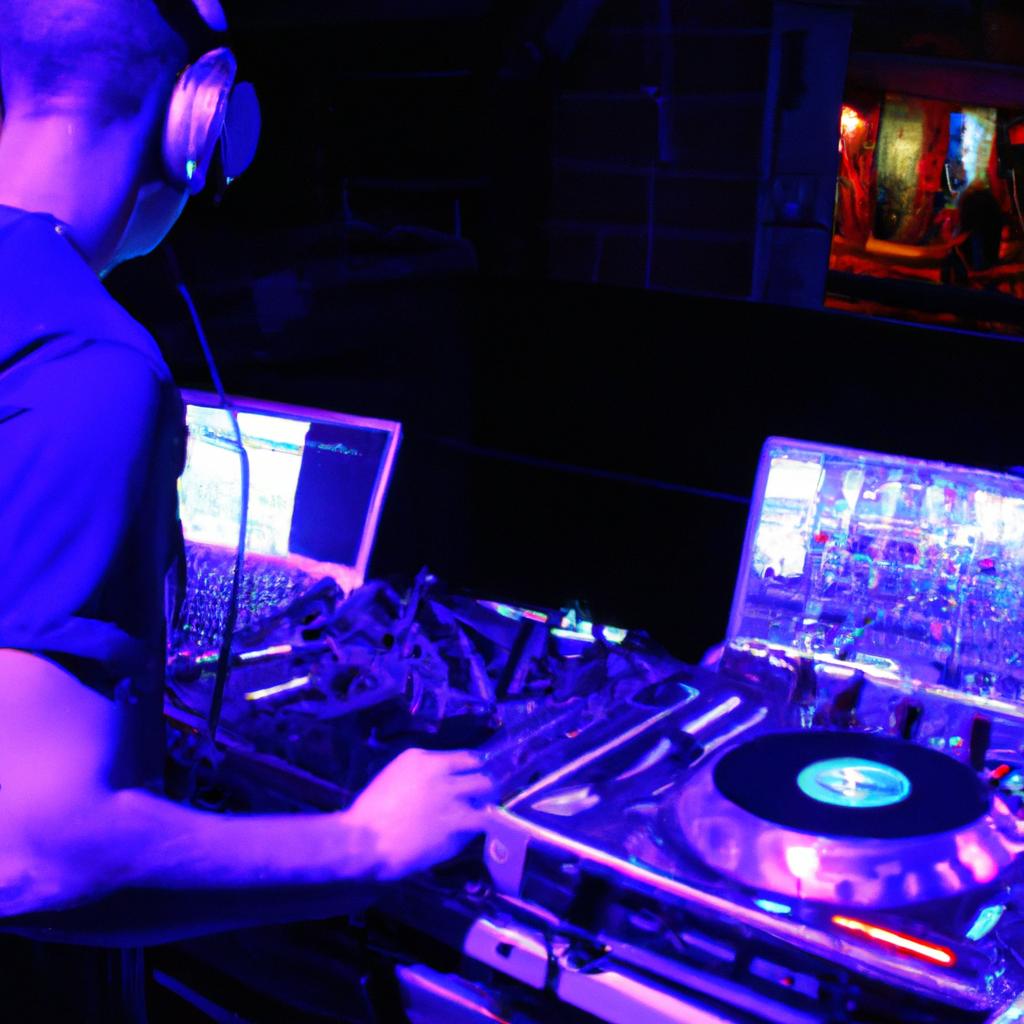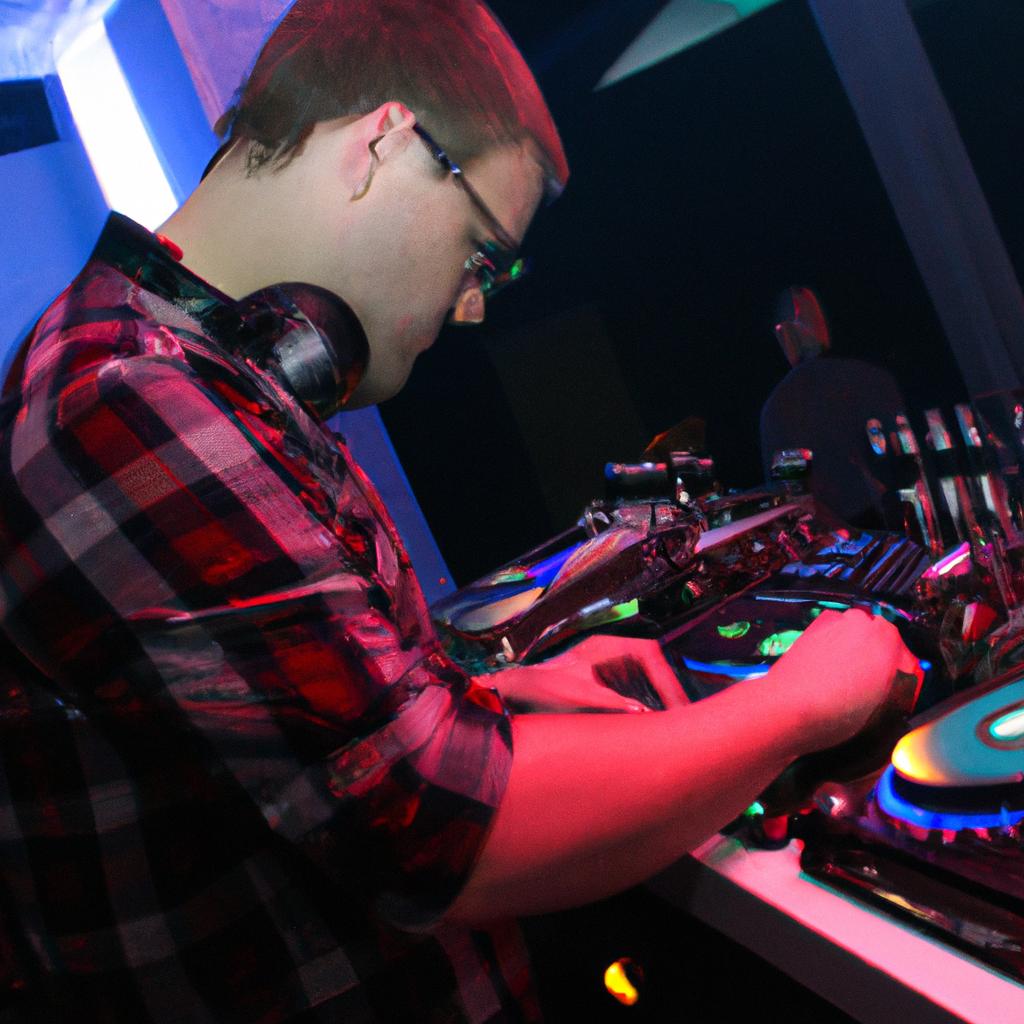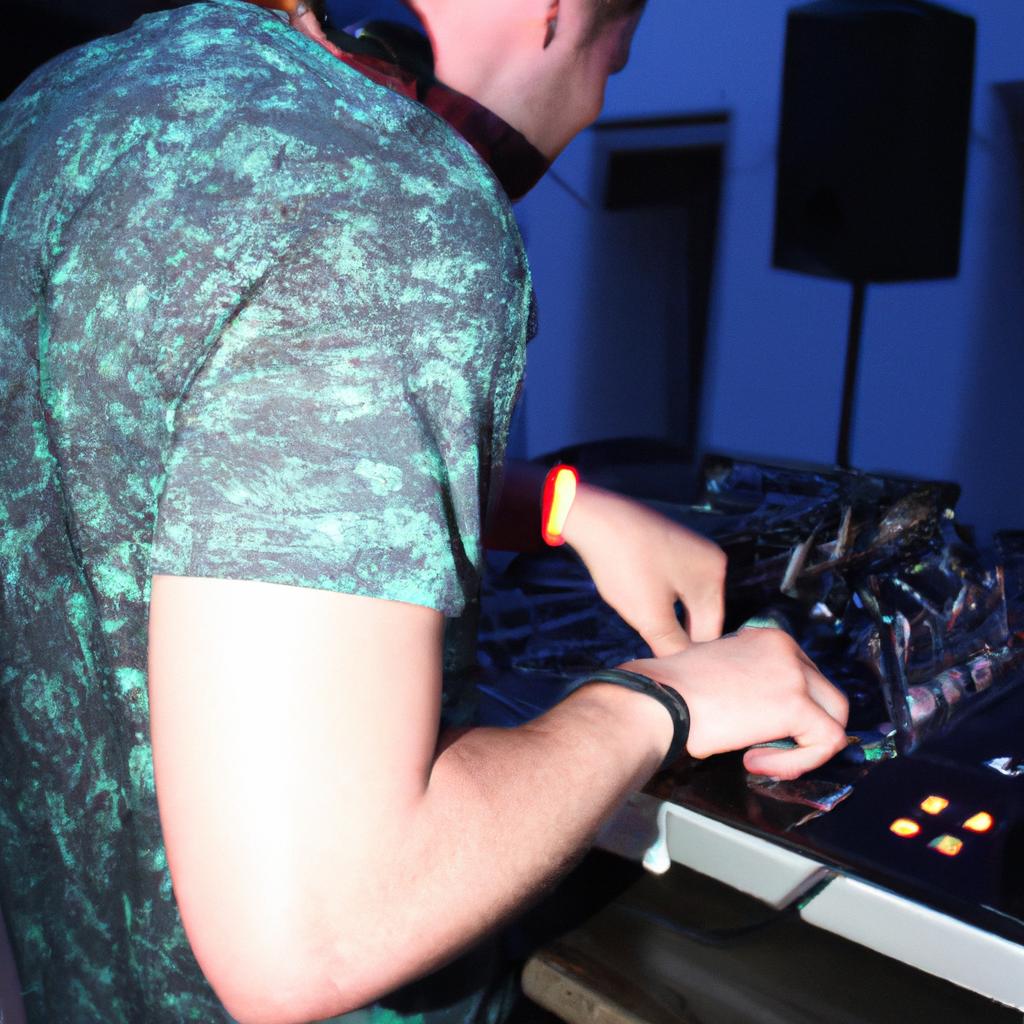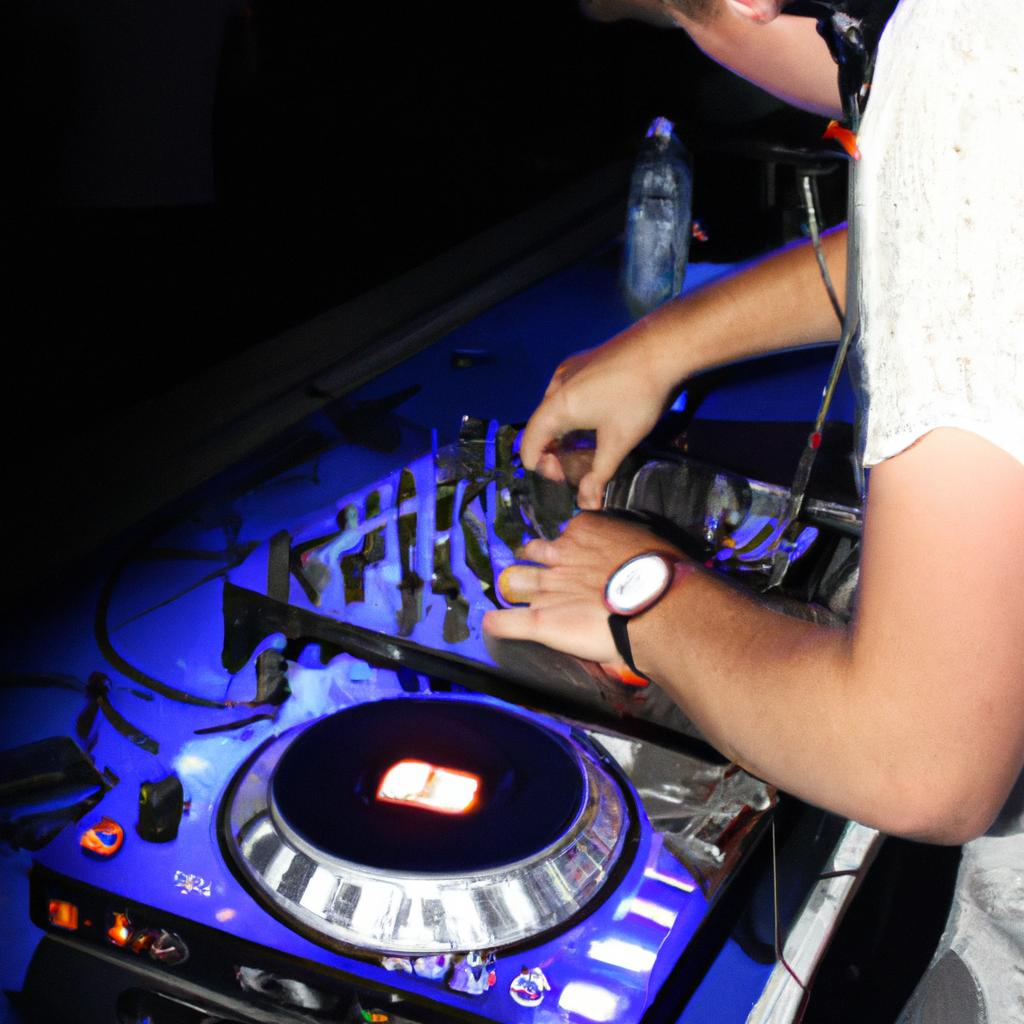DJ Set Preparation: A Guide for Dance & Nightclub Performances
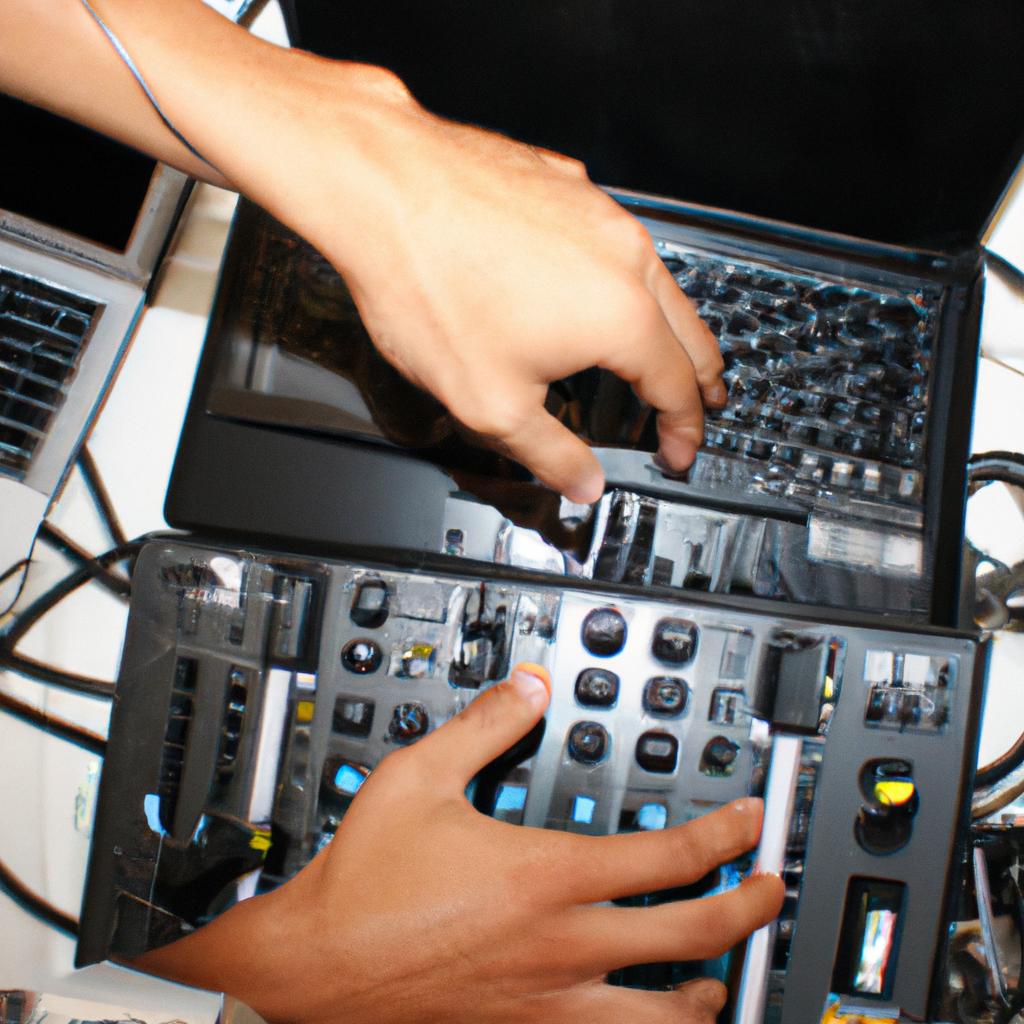
In the world of electronic music, DJs play a crucial role in creating an electrifying atmosphere that captivates audiences on dancefloors and in nightclubs. However, behind every seamless mix and high-energy performance lies hours of meticulous preparation. This article aims to provide a comprehensive guide for DJ set preparation, offering valuable insights into the essential steps and considerations involved in crafting a memorable musical journey for dance enthusiasts.
To illustrate the importance of proper DJ set preparation, let us consider the hypothetical case of DJ X performing at a popular nightclub. As the doors swing open, eager club-goers flood into the venue, eagerly anticipating a night filled with pulsating beats and infectious melodies. In this scenario, DJ X’s success hinges not only on their ability to read the crowd but also on their diligent pre-performance groundwork. From selecting appropriate tracks that match the vibe of the evening to organizing playlists strategically, each step taken during set preparation contributes significantly to the overall experience delivered by DJ X.
Understanding the Venue and Audience
To ensure a successful DJ set, it is crucial to have a comprehensive understanding of both the venue and the audience. Let’s consider an example scenario: Imagine you are booked to perform at a popular nightclub known for its energetic crowd. By comprehending the unique aspects of this specific venue and knowing your target audience, you can tailor your performance accordingly.
One important aspect to take into account is the size of the venue. A small intimate club will require a different approach compared to a large-scale dance floor. In smaller venues, where space might be limited, it becomes essential to create an atmosphere that encourages interaction between yourself as the DJ and the audience. On the other hand, larger clubs offer more room for experimentation with visuals and stage presence, allowing for grander performances that captivate a massive crowd.
Understanding your audience demographics is equally vital in delivering an unforgettable experience. Consider factors such as age range, musical preferences, and cultural backgrounds. For instance, if your case study involves performing at a nightclub primarily catering to electronic music enthusiasts ranging from 18-25 years old, it would be wise to focus on contemporary electronic genres like house or techno instead of playing older classics.
In order to connect with your audience on a deeper level, here are some key points worth considering:
- Energy Level: Gauge the energy level of the crowd throughout various moments during your set.
- Song Selection: Choose tracks that resonate with the expectations and taste of your audience.
- Flow & Transition: Pay attention to seamless transitions between songs to maintain momentum on the dancefloor.
- Genre Flexibility: Be prepared with diverse musical styles that could cater to unexpected shifts in mood or requests.
By taking these considerations into account while preparing for a DJ set at any given venue, you increase your chances of creating an immersive experience that resonates deeply with attendees. With knowledge about how venue size impacts stage presence and understanding your audience’s expectations, you can curate a set that ensures an unforgettable night of music and dancing.
Transitioning into the subsequent section about “Selecting the Right Equipment,” it is imperative to discuss how having appropriate gear enhances your performance.
Selecting the Right Equipment
Understanding the Venue and Audience:
When preparing for a DJ set, it is crucial to have a deep understanding of both the venue and audience you will be performing for. Let’s consider an example where you are scheduled to play at a popular dance club in a vibrant city known for its diverse music scene. This particular club attracts a young crowd who are enthusiastic about electronic dance music (EDM) and enjoy high-energy performances.
To ensure that your DJ set resonates with the venue and audience, there are several key factors to consider:
-
Music Genre Selection: Tailoring your music selection to match the preferences of the audience is essential. In this case, focusing on EDM subgenres like house, techno, or trance would likely appeal to the target demographic. However, it is also important to gauge the crowd’s response during your performance and adjust accordingly if necessary.
-
Energy Level: The energy level of your set should align with the atmosphere of the venue and expectations of the audience. Maintaining a consistent flow by gradually building up intensity can create anticipation and excitement among dancers. Utilizing dynamic transitions between tracks can help maintain momentum throughout your performance.
-
Timing: Understanding peak hours at the venue is vital as it dictates when you will perform and how long your set will last. Typically, peak hours coincide with higher attendance levels and increased energy on the dance floor. By strategically planning your track selections based on these timings, you can maximize their impact.
-
Engaging Performance Techniques: Captivating visuals, lighting effects, or live remixing can enhance your overall performance experience and leave a lasting impression on attendees.
By considering these aspects while preparing for your DJ set, you can better connect with the venue and audience, ensuring an unforgettable night filled with electric energy and memorable moments.
| Key Factors | Examples |
|---|---|
| Music Genre | House |
| Techno | |
| Trance | |
| Energy Level | Gradually build up |
| Dynamic transitions | |
| Timing | Peak hours |
| Engaging Techniques | Visuals |
| (Performance) | Lighting effects |
As you move forward in your DJ set preparation, the next section will guide you through selecting the right equipment to bring your performance to life. Remember, having a solid understanding of the venue and audience sets the foundation for a successful night behind the decks.
Transitioning into the subsequent section about “Organizing and Preparing Your Music Library,” it is essential to ensure that your music collection aligns seamlessly with your chosen genre and desired energy level.
Organizing and Preparing Your Music Library
In our hypothetical case study, let’s consider DJ Alex, who is preparing for a high-energy dance performance at a popular nightclub. After carefully selecting his music genre and style, DJ Alex now needs to focus on choosing the right equipment to ensure an unforgettable experience for his audience.
To begin with, having reliable and top-quality gear is essential. DJ controllers or turntables are commonly used in modern DJ setups. These devices provide seamless control over tracks, allowing DJs like Alex to mix and manipulate songs effortlessly. Additionally, investing in professional-grade headphones will enable him to accurately monitor transitions between tracks and make precise adjustments as needed.
Next, it is crucial for DJ Alex to have a stable audio setup that delivers clear sound throughout the venue. High-powered speakers and subwoofers should be strategically placed to create an immersive auditory experience for the crowd. Furthermore, using a mixer with multiple channels allows him to seamlessly transition from one track to another while maintaining consistent volume levels.
Lastly, considering lighting effects can enhance the overall atmosphere of DJ performances. LED lights synchronized with the beat of the music can create captivating visual displays that engage the audience even further. Incorporating smoke machines or lasers can add depth and excitement to the ambiance of the nightclub.
The selection of equipment greatly impacts both the technical aspects and emotional engagement of any DJ set. By ensuring quality gear, reliable audio systems, and appealing lighting effects are in place, DJs like Alex can elevate their performances to new heights – immersing their audiences in a multisensory experience they won’t soon forget.
Now let’s move on to exploring how organizing and preparing your music library contributes to crafting an exceptional DJ setlist and flow.
Creating a Setlist and Flow
Creating a Setlist and Flow
Building upon the well-organized music library, the next crucial step in DJ set preparation is creating a setlist and ensuring a smooth flow throughout your performance. A carefully crafted setlist can elevate the energy on the dancefloor and keep the crowd engaged. In this section, we will explore techniques for selecting tracks, arranging them in an optimal sequence, and maintaining a dynamic atmosphere.
Creating an impactful setlist requires careful consideration of various factors such as genre, BPM (beats per minute), key compatibility, and audience preferences. Let’s consider an example to illustrate this process: imagine you are preparing for a high-energy house music night at a popular nightclub. To capture the essence of that energetic vibe, you would want to select tracks with driving basslines and infectious rhythms while keeping them within a similar BPM range.
To ensure a seamless transition between tracks, it is essential to pay attention to both musical and technical aspects. One effective technique is using harmonic mixing – aligning songs with compatible keys to create smoother blends. By doing so, you enhance the overall listening experience for your audience by avoiding dissonant clashes between melodies or harmonies.
Now let’s dive into some practical tips to help structure your setlist effectively:
- Start strong: Begin with an attention-grabbing track that sets the tone for the entire performance.
- Build momentum: Gradually increase the energy level by introducing tracks with slightly higher BPMs and more intense elements.
- Create peaks and valleys: Alternate between high-energy moments and brief lulls or breakdowns to provide contrast and allow dancers to catch their breath.
- End memorably: Finish on a high note by selecting a powerful closing track that leaves a lasting impression on your audience.
- Euphoria-inducing drops
- Infectious grooves that make bodies move involuntarily
- Intense build-ups leading to explosive releases
- Harmonic blends that create a sense of musical cohesion
Emotional Response Table:
| Emotion | Track Examples |
|---|---|
| Excitement | “Dancing Queen” by ABBA, “Uptown Funk” by Mark Ronson ft. Bruno Mars |
| Euphoria | “Levels” by Avicii, “One More Time” by Daft Punk |
| Nostalgia | “Don’t Stop Believin’” by Journey, “I Will Survive” by Gloria Gaynor |
| Energy Surge | “Sandstorm” by Darude, “Insomnia” by Faithless |
By carefully curating your setlist and considering the emotional impact each track can have on the dancefloor, you will be able to captivate your audience from start to finish. In our subsequent section about mixing techniques and transitions, we will explore how to seamlessly blend tracks together for a fluid DJ performance.
With the foundation of an engaging setlist in place, let’s now delve into mastering essential mixing techniques and seamless transitions between songs.
Mixing Techniques and Transitions
Building on the importance of seamless transitions and a well-structured setlist, let us now delve into the art of mixing techniques and transitions. By mastering these skills, DJs can take their performances to new heights, captivating dancefloors with an uninterrupted flow of music.
To illustrate the significance of smooth mixing techniques, consider the following scenario: imagine you are DJing at a popular nightclub, and the dancefloor is pulsating with energy as club-goers eagerly await your next track. The current song has reached its climax, and it’s time for you to make the transition to a new track. As you flawlessly blend in the intro of the upcoming song while fading out the outro of the previous one, a surge of excitement ripples through the crowd. This moment exemplifies how skillful mixing techniques can elevate any performance by seamlessly linking tracks together.
To achieve this level of mastery over mixing techniques and transitions, keep in mind these key principles:
- Beatmatching: Ensuring that both songs have matching beats per minute (BPM) is crucial for creating harmonious blends. Utilize features like sync buttons or manual adjustments to align tempos accurately.
- Phrase Matching: Aligning musical phrases ensures that changes occur at appropriate moments within a song structure. It allows for smoother transitions between tracks without disrupting their natural flow.
- EQ Mixing: Skillfully adjusting equalizer levels during transitions helps maintain balance across frequency ranges while avoiding abrupt shifts in sound dynamics.
- Creative Transitions: Experiment with various transition methods such as loop rolls, acapella mixes, or using effects like delay or reverb to add depth and texture to your sets.
Using bullet points:
- A perfectly executed mix creates a sense of anticipation among listeners.
- Harmonizing BPMs enhances rhythm continuity throughout your set.
- Seamlessly blending phrase structures maintains cohesiveness between tracks.
- Employing creative transitions adds flair and individuality to your performance.
Consider the following table that showcases different mixing techniques:
| Mixing Technique | Description | Appropriate Use |
|---|---|---|
| Beatmatching | Matching beats per minute for seamless integration | Blending two tracks with similar tempos |
| Phrase Matching | Aligning musical phrases for smooth song transitions | Transitioning between verses or choruses |
| EQ Mixing | Adjusting equalizer levels to ensure balanced sound quality | Maintaining consistent audio dynamics during a transition |
| Creative Transitions | Adding unique elements to create memorable mix moments | Engaging listeners through unexpected changes in music style |
As DJs refine their skills in these areas, they will develop an intuitive sense of how each technique can be applied to enhance their performances. By seamlessly blending songs and utilizing innovative transitions, DJs can captivate dancefloors and leave lasting impressions on their audiences.
With a solid understanding of mixing techniques and transitions under our belt, it’s time to move on to another crucial aspect of DJ set preparation – soundcheck and technical considerations.
Soundcheck and Technical Considerations
In the previous section, we explored various mixing techniques and transitions that DJs can employ during their sets to create seamless and engaging performances. Now, let us delve into another crucial aspect of DJ set preparation: soundcheck and technical considerations.
To illustrate the importance of a thorough soundcheck, consider this hypothetical scenario: DJ X is scheduled to perform at a popular nightclub. However, due to inadequate time for soundchecking, they encounter numerous technical issues during their set. The bass levels are overpowering, leading to distortion in the music, while the microphone feedback disrupts the overall experience. Consequently, DJ X’s performance falls short of expectations, leaving both themselves and the audience disappointed.
To avoid such mishaps and ensure a smooth performance, here are some key factors to consider during your soundcheck:
- Volume Levels: Adjusting volume levels is essential for maintaining balance throughout your set. Be mindful of not only the master volume but also individual track volumes to prevent sudden spikes or drops that may jar the listeners.
- Equalization (EQ): Utilize EQ tools effectively to shape the frequency response of each track. Clear out any unnecessary frequencies and highlight desired elements like vocals or instrumentals by boosting or cutting specific bands.
- Effects Processing: Experiment with different effects processors such as reverb, delay, or filters to add depth and texture to your tracks. However, exercise caution so as not to overwhelm the mix with excessive processing.
- Monitor Setup: Position your monitors correctly for optimal audio monitoring. Ensure they are adequately isolated from external noise sources and positioned at ear level for accurate representation of your mix.
- Exhilaration when executing flawless transitions
- Frustration when encountering technical difficulties mid-set
- Satisfaction from witnessing crowd reactions
- Disappointment when unable to meet audience expectations
Now incorporating a table:
| Technical Considerations | Emotional Impact |
|---|---|
| Thorough soundcheck | Minimizing performance issues |
| Balanced volume levels | Enhanced listening experience |
| Effective EQ techniques | Improved track clarity |
| Optimal monitor setup | Accurate audio monitoring |
In conclusion, a comprehensive soundcheck and attention to technical considerations are crucial for DJs in preparing their sets. By addressing these factors diligently, you can create an immersive musical journey that not only captivates the audience but also elevates your own performance. So remember, investing time and effort into this aspect of DJ set preparation will undoubtedly pay off in delivering memorable experiences on the dancefloor.


